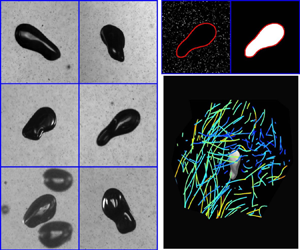Crossref Citations
This article has been cited by the following publications. This list is generated based on data provided by
Crossref.
Ma, Tian
Ott, Bernhard
Fröhlich, Jochen
and
Bragg, Andrew D.
2021.
Scale-dependent anisotropy, energy transfer and intermittency in bubble-laden turbulent flows.
Journal of Fluid Mechanics,
Vol. 927,
Issue. ,
Soligo, Giovanni
Roccon, Alessio
and
Soldati, Alfredo
2021.
Turbulent Flows With Drops and Bubbles: What Numerical Simulations Can Tell Us—Freeman Scholar Lecture.
Journal of Fluids Engineering,
Vol. 143,
Issue. 8,
Håkansson, Andreas
2021.
Towards a Standard Method for Estimating Fragmentation Rates in Emulsification Experiments.
Processes,
Vol. 9,
Issue. 12,
p.
2242.
Masuk, Ashik Ullah Mohammad
Qi, Yinghe
Salibindla, Ashwanth K.R.
and
Ni, Rui
2021.
Towards a phenomenological model on the deformation and orientation dynamics of finite-sized bubbles in both quiescent and turbulent media.
Journal of Fluid Mechanics,
Vol. 920,
Issue. ,
Masuk, Ashik Ullah Mohammad
Salibindla, Ashwanth K.R.
and
Ni, Rui
2021.
The orientational dynamics of deformable finite-sized bubbles in turbulence.
Journal of Fluid Mechanics,
Vol. 915,
Issue. ,
Salibindla, Ashwanth K.R.
Masuk, Ashik Ullah Mohammad
and
Ni, Rui
2021.
Experimental investigation of the acceleration statistics and added-mass force of deformable bubbles in intense turbulence.
Journal of Fluid Mechanics,
Vol. 912,
Issue. ,
Ma, Tian
Hessenkemper, Hendrik
Lucas, Dirk
and
Bragg, Andrew D.
2022.
An experimental study on the multiscale properties of turbulence in bubble-laden flows.
Journal of Fluid Mechanics,
Vol. 936,
Issue. ,
Hessenkemper, H.
Starke, S.
Atassi, Y.
Ziegenhein, T.
and
Lucas, D.
2022.
Bubble identification from images with machine learning methods.
International Journal of Multiphase Flow,
Vol. 155,
Issue. ,
p.
104169.
Wang, Cheng
Yi, Lei
Jiang, Linfeng
and
Sun, Chao
2022.
Turbulence drag modulation by dispersed droplets in Taylor–Couette flow: the effects of the dispersed phase viscosity.
Journal of Fluid Mechanics,
Vol. 952,
Issue. ,
Czerski, Helen
Brooks, Ian M.
Gunn, Steve
Pascal, Robin
Matei, Adrian
and
Blomquist, Byron
2022.
Ocean bubbles under high wind conditions – Part 2: Bubble size distributions and implications for models of bubble dynamics.
Ocean Science,
Vol. 18,
Issue. 3,
p.
587.
Crialesi-Esposito, Marco
Rosti, Marco Edoardo
Chibbaro, Sergio
and
Brandt, Luca
2022.
Modulation of homogeneous and isotropic turbulence in emulsions.
Journal of Fluid Mechanics,
Vol. 940,
Issue. ,
Håkansson, Andreas
Olad, Peyman
and
Innings, Fredrik
2022.
Identification and Mapping of Three Distinct Breakup Morphologies in the Turbulent Inertial Regime of Emulsification—Effect of Weber Number and Viscosity Ratio.
Processes,
Vol. 10,
Issue. 11,
p.
2204.
Håkansson, Andreas
Crialesi-Esposito, Marco
Nilsson, Lars
and
Brandt, Luca
2022.
A criterion for when an emulsion drop undergoing turbulent deformation has reached a critically deformed state.
Colloids and Surfaces A: Physicochemical and Engineering Aspects,
Vol. 648,
Issue. ,
p.
129213.
Ruth, Daniel J.
Aiyer, Aditya K.
Rivière, Aliénor
Perrard, Stéphane
and
Deike, Luc
2022.
Experimental observations and modelling of sub-Hinze bubble production by turbulent bubble break-up.
Journal of Fluid Mechanics,
Vol. 951,
Issue. ,
Hessenkemper, Hendrik
Starke, S.
Atassi, Y.
Ziegenhein, T.
and
Lucas, D.
2022.
Bubble Identification from Images with Machine Learning Methods.
SSRN Electronic Journal ,
Håkansson, Andreas
and
Brandt, Luca
2022.
Deformation and initial breakup morphology of viscous emulsion drops in isotropic homogeneous turbulence with relevance for emulsification devices.
Chemical Engineering Science,
Vol. 253,
Issue. ,
p.
117599.
Hao, Xue-Ying
Li, Xiao-Bin
Zhang, Hong-Na
Zhang, Wen-Hua
and
Li, Feng-Chen
2023.
Review on multi-parameter simultaneous measurement techniques for multiphase flow - part B: Basic physical parameters and phase characteristics.
Measurement,
Vol. 220,
Issue. ,
p.
113397.
2023.
Bubble size distribution at early stage of hydrodynamic cloud cavitation.
Physics of Fluids,
Vol. 35,
Issue. 6,
Lewerentz, Frida
Pappas, Konstantinos
Bergenståhl, Björn
and
Håkansson, Andreas
2023.
The effect of disperse phase viscosity in the emulsification of a semi-dairy beverage–combining emulsification experiments and numerical single drop breakup simulations.
Food and Bioproducts Processing,
Vol. 138,
Issue. ,
p.
103.
Olad, Peyman
Innings, Fredrik
Crialesi-Esposito, Marco
Brandt, Luca
and
Håkansson, Andreas
2023.
Comparison of turbulent drop breakup in an emulsification device and homogeneous isotropic turbulence: Insights from numerical experiments.
Colloids and Surfaces A: Physicochemical and Engineering Aspects,
Vol. 657,
Issue. ,
p.
130569.


